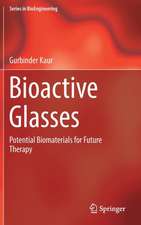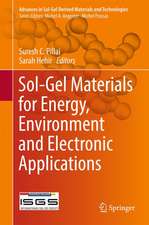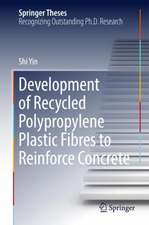Chemistry of Glasses
Autor A. Paulen Limba Engleză Hardback – 30 noi 1989
| Toate formatele și edițiile | Preț | Express |
|---|---|---|
| Paperback (1) | 584.43 lei 6-8 săpt. | |
| SPRINGER NETHERLANDS – 13 oct 2011 | 584.43 lei 6-8 săpt. | |
| Hardback (1) | 1662.55 lei 6-8 săpt. | |
| SPRINGER NETHERLANDS – 30 noi 1989 | 1662.55 lei 6-8 săpt. |
Preț: 1662.55 lei
Preț vechi: 2027.50 lei
-18% Nou
Puncte Express: 2494
Preț estimativ în valută:
318.23€ • 345.78$ • 267.49£
318.23€ • 345.78$ • 267.49£
Carte tipărită la comandă
Livrare economică 21 aprilie-05 mai
Preluare comenzi: 021 569.72.76
Specificații
ISBN-13: 9780412278204
ISBN-10: 0412278200
Pagini: 368
Ilustrații: XII, 368 p.
Dimensiuni: 210 x 297 x 22 mm
Greutate: 0.71 kg
Ediția:2nd ed. 1990
Editura: SPRINGER NETHERLANDS
Colecția Springer
Locul publicării:Dordrecht, Netherlands
ISBN-10: 0412278200
Pagini: 368
Ilustrații: XII, 368 p.
Dimensiuni: 210 x 297 x 22 mm
Greutate: 0.71 kg
Ediția:2nd ed. 1990
Editura: SPRINGER NETHERLANDS
Colecția Springer
Locul publicării:Dordrecht, Netherlands
Public țintă
ResearchRecenzii
'I am delighted to have had the opportunity to review this book; it is a must for scholars in this field, and I would heartily recommend it to those who even have only a passing interest in the subject of chemistry of glasses.' Glass Technology (Review of previous edition); 'A contribution to the field of glass science that will be highly welcome by all members of this field. The book is authoritative, well written, and illustrated in a highly useful manner...This book will be regarded as an important addition to all glass and ceramic libraries throughout the world.' Choice (Review of previous edition); 'expositions are generally clear and succinct' - Journal of Materials Chemistry
Cuprins
1 Glass Formation.- 1.1 General Aspects.- 1.2 Glass Formers.- 1.3 Atomistic Hypotheses of Glass Formation.- 1.4 Kinetic Approach to Glass Formation.- 2 Phase Transformations in Glass.- 2.1 Crystallization.- 2.2 Liquid -Liquid Phase Separation.- 2.3 Glass-Ceramics.- 3 Physical Properties.- 3.1 Density of Glasses.- 3.2 Partial Molar Volume of Constituent Oxides in Glasses and Melts.- 3.3 Refractive Index of Glasses.- 3.4 Thermal Expansion of Glasses.- 3.5 Viscosity of Glasses.- 3.6 Surface Tension of Glasses.- 3.7 Electrical Properties of Glasses.- 4 Chemical Durability of Glass.- 4.1 Mechanism of Reactions of Glasses with Aqueous Solution.- 4.2 Factors Affecting Chemical Durability Measurements of a Glass.- 4.3 Effect of Glass Composition.- 4.4 Effect of pH of the Solution on Chemical Durability of SiO2 (quartz).- 4.5 Solubility of Silica in Aqueous Solutions.- 4.6 Glass Electrodes.- 5 Oxidation-Reduction Equilibrium in Glass.- 5.1 General.- 5.2 Activity Corrections.- 5.3 Oxidation -Reduction in Glass.- 5.4 Theory of Redox Reactions in Solutions.- 6 Acid-Base Concepts in Glass.- 6.1 Introduction.- 6.2 Acid-Base Relationships in Glasses.- 6.3 Oxygen Ion Activity.- 6.4 Transition Metal Ions as Acid-Base Indicators in Glass.- 6.5 Oxidation-Reduction Equilibrium in Glass.- 6.6 Filled Shell Ions with ns2 Configuration as an Acid-Base Indicator in Glass.- 6.7 Vanadylion as an Acid-Base Indicator in Glass.- 7 Coloured Glasses.- 7.1 Atomic Structure and the Periodic Classification of Transition Metals.- 7.2 Theories of Chemical Bonding in Transition Metal Complexes.- 7.3 Application of Bonding Theories in Interpreting d-d Absorption Spectra.- 7.4 Absorption Spectra of Transition Metal Ions.- 7.5 Charge-Transfer Bands.- 7.6 Anionic Substitution in Glass.- 7.7 Photosensitive Glasses.- 7.8 Copper Ruby Glasses.- 7.9 Measurement of Colour, Colour Diagram and Tristimulus Values.- 8 Polymetric Nature of Glass Melts.




















